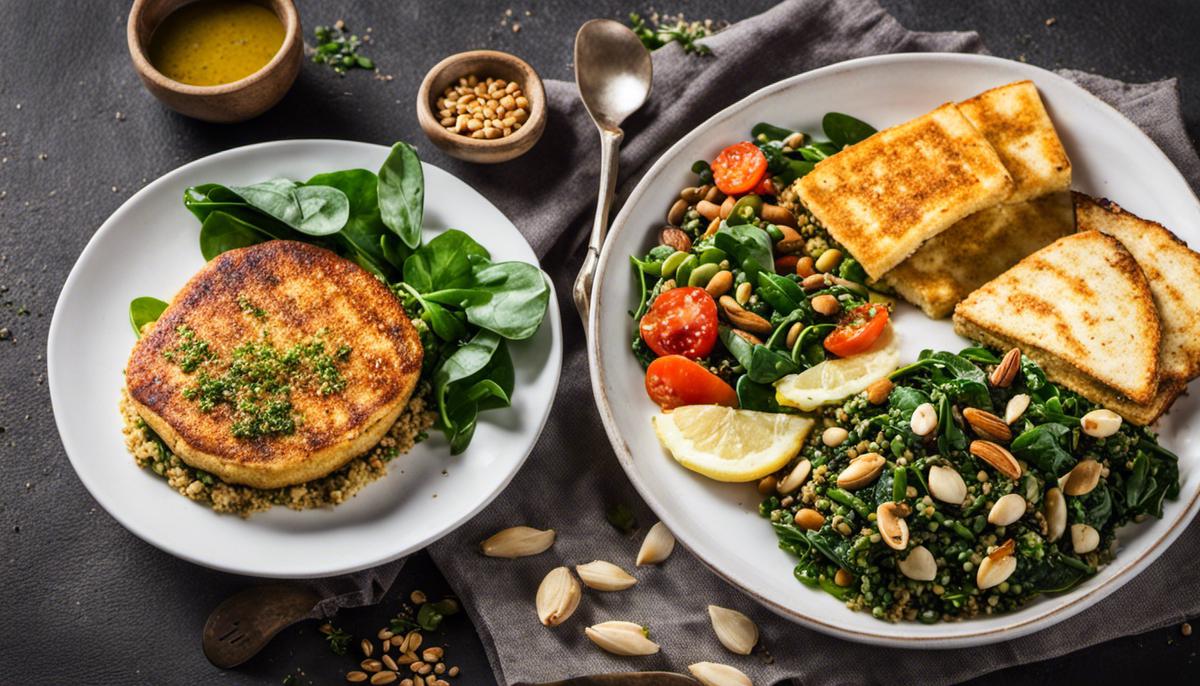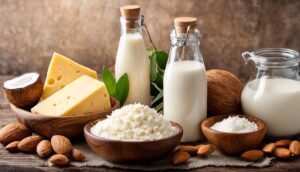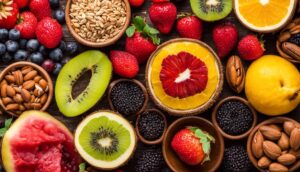Protein is a critical macronutrient that supports multiple functions in our bodies – from building and repairing tissues to making enzymes, hormones, and other chemicals. Yet, there’s an ongoing misconception that high-protein meals are solely confined within the realms of animal-based diets. In our rapidly evolving food culture characterized by individual dietary preferences and needs, there’s a growing recognition for the myriad ways to benefit from high-protein vegetarian meals. This exploration focuses on understanding the protein content in legumes, nuts, seeds, and whole grains, as well as the art of creatively combining these ingredients to ensure a well-balanced, protein-rich diet. Additionally, this piece illuminates various cooking techniques that can amplify the protein content and flavor profile of your vegetarian dishes.
Understanding Protein Content in Vegetarian Foods
Article:
Elevate Your Vegetarian Fare: Mastering Protein Content in Plant-Based Meals
Protein is essential for maintaining healthy body functions and building muscles. But how do you maximize your nutritional intake when you’ve driven the steak and poultry off your plate? Fear not, you devoted herbivores. By incorporating a variety of protein-rich plant-based foods and using some clever cooking techniques, you’ll boost the protein content of your meals without missing a beat.
Legumes Rule
Vegetarians and vegans, meet your new best friends: beans, lentils, and chickpeas. Packed with protein, legumes can be seamlessly blended into your breakfast, lunch, dinner. Try a healthy dose of lentil soup on a chilly evening or whip up a chickpea salad brimming with fresh veggies for a light yet satisfying lunch. Don’t ignore the humble tofu either. Its versatility makes it an excellent addition to stir-fries, curries, sandwiches, salads or even scrambled ‘eggs’.
Whole Grains for the Win
Not only do whole grains add a pleasant nutty flavor and enhance the texture in your meals, but they are also packed with protein! Quinoa, for instance, is a complete protein that contains all the essential amino acids your body needs. Barley, bulgur, buckwheat, and brown rice are also excellent sources of protein. A hearty bowl of oatmeal for breakfast or mixed grain salad for lunch could up your protein game.
Seeds and Nuts: Snacks that Pack a Punch
From ground almonds and flaxseeds sprinkled over your morning smoothie bowl to the simple yet sublime peanut butter smeared on whole grain toast, the inclusion of seeds and nuts in your daily meals can boost your protein intake significantly. Explore with raw, roasted, or even sprouted versions and keep the crunch factor going in your diet!
The Green Machines
Don’t forget about the protein power that leafy greens and veggies bring to the table! Spinach, kale, broccoli, peas, and artichokes are excellent sources to get your green protein fix. Reinvent the classic pasta by tossing in a handful of spinach or grilled asparagus. Think beyond salads!
Unleash the Proteins with Tempering
Maximize the absorption of protein in legumes and grains by employing clever cooking techniques. Soaking, sprouting, and fermenting are effective ways of reducing phytic acid, which can inhibit the absorption of proteins in your body. These methods not only increase protein availability but also enhance flavors—a win-win!
Easy Pea-sy Proteins
Finally, consider integrating plant-based protein powders, like pea protein or hemp protein into your meals. A scoop in your morning smoothie or blended into your preferred almond milk can deliver a protein boost without the need to prep or cook.
Protein-rich, plant-based meals do not have to be dull or one-dimensional. Actually, the journey to reimagine your menu could be a culinary adventure, breathing new life into your diet while looking after your health. So, tie on that apron, and embrace the challenge of maximizing protein in your vegetarian meals. The creativity and rewards in your kitchen are limitless!

Creatively Combining Ingredients for Protein Balance
Creating a balanced, high-protein vegetarian meal may seem intimidating at first. However, let your taste buds explore the myriad of flavor profiles that plant-based foods have to offer, and you'll be amazed how quickly you can become a master of this cuisine. There's an incredible symphony of taste - from earthy lentils, nutty quinoa to green spinach, creating a tantalizing and protein-filled plate is all about the right ingredients.
Embark on a culinary journey by building and layering flavors, pairing proteins with other nutritious foods and utilizing a variety of cooking techniques. One of the most effective methods to do this is through fusion. Think about a succulent pan-fried tofu encased in a crust of sesame seeds, served over a bed of slightly tart and filling quinoa salad. Fusion not only elevates your meal but also ensures nutrient diversity.
Vegetables are like the vibrant paints on a canvas; they bring the much needed color and additional nutritive elements to your meal. For a protein punch, choose vegetables that offer bountiful protein such as peas or artichokes, perfectly cooked to a delightful crunch. It is vital not just to consider the protein content but also the additional phytonutrients these wonder foods can provide.
The magic of an ensemble comes alive when you sprout or ferment your legumes. The nutty crispness of sprouted mung beans tossed in a salad or the savoury tang of fermented chickpeas in a hummus lights up your plate and adds a delightful crunch or smoothness to your meal.
In your culinary adventure, don't forget the often-overlooked green leafy vegetables that have decent protein content. How about a sauteed kale or spinach with a dash of garlic and sprinkles of toasted almonds? Lean into the hearty textures and flavors these vegetables bring to make your meal lively and stimulating.
Apart from these, using plant-based protein powders can bring a delightful spin to your meals. Try whipping up savory pancakes or muffins using plant-based protein powders and serve them with a side of stir-fried vegetables for a filling, high-protein meal.
Finding subtlety in simplicity, explore a legion of legumes paired with whole grains. Infuse them with a dazzling array of herbs and spices to create protein-packed curries, stews, or soups.
Lastly, let your kitchen become a playground of flavor creativity. Play around with various elements - crunchy, soft, smooth, crispy, spicy, biting, sweet, or tangy. Remember that the variety of textures and flavors will add depth and interest to your meals while keeping them protein-rich.
So, put on your apron, pep up your pantry, and surprise yourself with the myriad high-protein meals that await. Food connects people, and such meals will have friends begging for your secret ingredients. And isn't that part of the joy? Happy cooking!

Vegetarian Cooking Techniques for Enhanced Protein
Boosting Protein Content in Tempeh: Next-Level Your Vegetarian Dishes
One often overlooked yet highly protein-dense food is tempeh, a fermented soybean product hailing from Indonesia. Tempeh delivers an impressive 16 grams of protein per 3.5-ounce serving, all while offering the added bonus of probiotics, courtesy of the fermentation process.
But to truly tease the protein out of tempeh, marinating is your secret weapon. In doing so, not only will you impart delectable flavors, but the soaking process will also break down the food structure, making it easier for your body to access and absorb all of that soy protein.
Seitan is another protein powerhouse amongst the plant-based crowd, composed almost entirely of protein derived from gluten, a mix of wheat proteins. Weighing in with an impressive 25 grams of protein per 3.5-ounce serving, seitan shines as a veritable protein beast in the vegetarian sphere. Try it braised, stewed, grilled, or pan-fried; each method unlocks unique textures while maintaining its protein content.
Edamame: The Perfect Protein Side Dish
Edamame, or immature soybeans, are yet another example of vegetables that can pack a punch in the protein department. With nine grams of protein per half cup, these green gems can be easily integrated into many different dishes. Super versatile, they can be used in salads, stir-fries, or simply salted as a healthy snack. You can also blend them into a rich, creamy hummus, giving the classic chickpea spread a protein boost.
Revamp your Portobello: The Meaty Undertone
Mushrooms, especially the meaty and large varieties like Portobellos, lend an earthy flavor profile and meat-like texture while providing some protein. Though their protein levels are lower compared to their legume contemporaries, grilling or broiling can accentuate their flavor, making them an essential component of a hearty and satisfying protein-rich vegetarian meal.
The Power of Protein Complementation
The cooking technique of ‘protein complementation’ or combining various types of plant-based protein sources, can help vegetarians achieve a complete protein profile, covering all nine essential amino acids our bodies need. Think classic corn and beans, or rice and lentils; these duos aren’t just delicious, but also provide a perfectly balanced protein.
The Art of Scrambling (without eggs!)
If you thought the protein-rich palettes of a morning scramble delight were out of reach due to your vegetarian lifestyle, think again. A tofu scramble offers a high-protein breakfast alternative that leaves nothing to miss. Well-seasoned and pan-tumbled with your favorite veggies, this simple dish can kickstart your day with a protein punch.
End Note
Don’t shy away from exploring the vast spectrum of vegetables, protein-packed grains, and fermented delights at disposals. Take advantage of the complementary protein technique, and don’t underestimate the power of marinating and the versatility of tofu. With the right cooking methods and a dash of creativity, vegetarian meals can be just as protein-filled as their meat-based counterparts. Make every mouthful matter in your pursuit of a protein-rich vegetarian lifestyle.

Engaging with the process of creating nutritious, protein-rich vegetarian meals requires a degree of understanding, creativity, and skill. By expanding our understanding of the protein content in diverse vegetarian sources such as legumes, nuts, seeds, and whole grains, we discard the unwarranted notion that vegetarian meals lack sufficient protein. Further, the art of combining various ingredients creatively, each with their unique flavor profiles and nutrient composition, helps us build meals that are both balanced and delightful. Lastly, getting acquainted with different cooking techniques and seasoning methods adds yet another layer to our meal preparation experiences, solidifying our control over the nutrition and flavor dynamics of our choices. This knowledge, combined with an experimentation-friendly attitude, can enable us to reliably prepare satisfying, high-protein vegetarian meals that do not compromise on taste or health.





